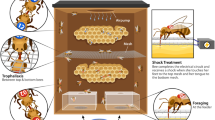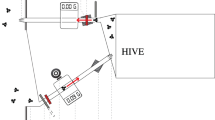Abstract
When forager honeybees (Apis mellifera) return to the hive after a successful foraging trip, they unload the collected liquid to recipient hive mates through mouth-to-mouth contacts (trophallaxis). The speed at which the liquid is transferred (unloading rate) from donor to recipient is related to the profitability of the recently visited food source. Two main characteristics that define this profitability are the flow of solution delivered by the feeder and the time invested by the forager at the source (visit time). To investigate the effect of visit time on trophallactic behaviour, donor foragers were trained to a rate feeder that could deliver different flows of solution. We dissociated visit time and flow of solution by introducing pauses in the solution's deliverance at different moments of the foraging visit. We analysed whether timing of the non-deliverance period within the visit is important for the forager's assessment of resource profitability. During the subsequent trophallactic encounter with a hive mate, unloading rate was related to the total time invested by the forager at the food source only if the ingestion process had already been started. These results together with previous ones suggest that foragers integrate an overall flow rate of solution of the feeder throughout the entire foraging visit.

Similar content being viewed by others
References
Cogorno GD, Fernández PC, Farina WM (1998) Honeybees' dancing behaviour is modulated according to the sugar flow rate of the exploited nectar source. In: Elsner N, Wehner R (eds) New neuroetology on the move. Proc 26th Goettingen Neurobiol Conf. Thieme, Stuttgart, p 96
Couvillon PA, Bitterman ME (1984) The overlearning-extinction effect and successive negative contrast in honeybees (Apis mellifera). J Comp Psychol 98:100–109
Esch HE, Burns JE (1996) Distance estimation by foraging honeybees. J Exp Biol 199:155–162
Farina WM (1996) Food-exchange by foragers in the hive—a means of communication among honey bees? Behav Ecol Sociobiol 38:59–64
Farina WM (2000) The interplay between dancing and trophallactic behavior in the honey bee Apis mellifera. J Comp Physiol A 186:239–245
Farina WM, Núñez JA (1991) Trophallaxis in the honeybee, Apis mellifera (L.) as related to the profitability of food sources. Anim Behav 42:389–394
Farina WM, Núñez JA (1993) Trophallaxis in honey bees: transfer delay and daily modulation. Anim Behav 45:1227–1231
Farina WM, Wainselboim AJ (2001) Changes in the thoracic temperature of honeybees while receiving nectar from foragers collecting at different reward rates. J Exp Biol 204:1653–1658
Flaherty CF (1982) Incentive contrast: a review of behavioral changes following shifts in reward. Anim Learn Behav 10:409–440
Frisch K von (1965) Tanzsprache und Orientierung der Bienen. Springer, Berlin Heidelberg New York
Fülöp A, Menzel R (2000) Risk-indifferent foraging behaviour in honeybees. Anim Behav 60:657–666
Greggers U, Menzel R (1993) Memory dynamics and foraging strategies of honeybees. Behav Ecol Sociobiol 32:17–29
Greggers U, Kuettner A, Mauelshagen J, Menzel R (1993) Optimization of honeybees with balanced US-qualities. In: Elsner N, Heisenberg M (eds) Gene brain—behaviour. Proc 21st Goettingen Neurobiol Conf. Thieme, Stuttgart, p 841
Istomina-Tsvetkova KP (1960) Contribution to the study of trophic relations in adult worker bees. XVII International Beekeeping Congress, Bologna-Roma, pp 361–365
Lindauer M (1948) Über die Einwirkung von Duft- und Geschmacksstoffen sowie anderer Faktoren auf die Tänze der Bienen. Z Vergl Physiol 31:348–412
Núñez JA (1966) Quantitative Beziehungen zwischen den Eigenschaften von Futterquellen und dem Verhalten von Sammelbienen. Z vergl Physiol 53:142–164
Núñez JA (1971) A simulator for learning studies in the bee Apis mellifera L. Acta Cient Venez 22 [Suppl]:101–106
Núñez JA (1977) Nectar flow by melliferous flora and gathering flow by Apis mellifera Ligustica. J Insect Physiol 23:265–275
Rau G (1970) Zur Steuerung der Honigmagenfüllung sammelnder Bienen an einer künstlicher Futterquelle. Z Vergl Physiol 66:1–21
Schmaranzer S, Stabentheiner A (1988) Variability of the thermal behavior of honeybees on a feeding place. J Comp Physiol B 158:135–141
Seeley TD (1986) Social foraging by honeybees: how colonies allocate foragers among patches of flowers. Behav Ecol Sociobiol 19:343–354
Seeley TD (1989) Social foraging in honey bee: how nectar foragers assess their colony's nutritional status. Behav Ecol Sociobiol 24:181–199
Seeley TD, Tovey A (1994) Why search time to find a food-storer bee accurately indicates the relative rates of nectar collecting and nectar processing in honey bee colonies. Anim Behav 47:311–316
Seeley TD, Camazine S, Sneyd J (1991) Collective decision-making in honey bees: how colonies choose among nectar sources. Behav Ecol Sociobiol 28:277–290
Stabentheiner A (1996) Effect of foraging distance on the thermal behaviour of honeybees during dancing, walking and trophallaxis. Ethology 102:360–370
Stabentheiner A, Hagmüller K (1991) Sweet food means "hot dancing" in honeybees. Naturwissenschaften 78:471–473
Stabentheiner A, Kovac H; Hagmüller K (1995) Thermal behavior of round and wagtail dancing honeybees. J Comp Physiol B 165:433–444
Varjú D, Núñez JA (1991) What do foraging honeybees optimize? J Comp Physiol A 169:729–736
Wainselboim AJ, Farina WM (2000a) Trophallaxis in the honeybee Apis mellifera (L.): the interaction between flow of solution and sucrose concentration of the exploited food sources. Anim Behav 59:1177–1185
Wainselboim AJ, Farina WM (2000b) Trophallaxis in filled-crop honeybees (Apis mellifera L.): food-loading time affects unloading behaviour. Naturwissenschaften 87:280–282
Wainselboim AJ, Roces F, Farina WM (2002) Honey bees assess changes in flow of solution within a single foraging bout. Anim Behav 63:1–6
Zar JH (1996) Biostatistical analysis, 3rd edn. Prentice Hall, London
Acknowledgements
This study was supported by funds from a PWA-Program (DAAD, Germany, and Fundación Antorchas, Argentina), and was performed during a visit by A.J.W. to the University of Würzburg, Würzburg (Germany). Additional financial support was provided by ANPCYT (PICT 98-03103) and by a grant from CONICET (Argentine Research Council). It was also partially supported by the German Research Council (SFB 554/TPC2). The present study complies with the Principles of Animal Care, publication No. 86-23, revised 1985 of the National Institute of Health and the current laws of the country in which the experiments were performed.
Author information
Authors and Affiliations
Corresponding author
Rights and permissions
About this article
Cite this article
Wainselboim, A.J., Roces, F. & Farina, W.M. Assessment of food source profitability in honeybees (Apis mellifera): how does disturbance of foraging activity affect trophallactic behaviour?. J Comp Physiol A 189, 39–45 (2003). https://doi.org/10.1007/s00359-002-0373-z
Received:
Revised:
Accepted:
Published:
Issue Date:
DOI: https://doi.org/10.1007/s00359-002-0373-z




